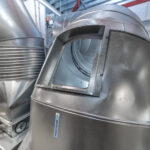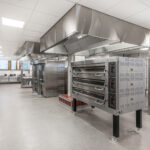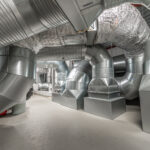The vocational college has the largest teaching kitchens in the Nordic countries. Under the same roof, you can find, among other things, 13 teaching kitchens, two confectionaries, food services, a café-store, a lunch restaurant for third-party customers as well as craft- and mass-production bakeries. The advantages of professional kitchen’s purification technologies and technical solutions in this extensive site multiply with each device.
Large airflow and structural limitations
Huge exhaust air quantities needed to be in control despite the low room height and structural beams. The most significant challenges posed by the amount of equipment in the renovation were the hanging and weight of the hoods and the optimal supply and exhaust air equipment design. In addition, several building technology systems had to be coordinated on the site.
“In planning, dimensioning, and equipment selection, special attention had to be paid to directing the air over a wide enough area at a low enough speed to avoid the feeling of the draft. In addition, we had to ensure that the working and corridor areas are used as efficiently as possible to bring in huge amounts of supply air,” says Esa Huuskonen from Climecon, who consulted in HVAC planning. With the help of ventilation ceiling solutions, it was possible to cover the large areas of the educational kitchens and the large volumes of air.
The high ceiling beams also limited the devices’ layout and the channeling between them. As a result, the locations of the connection joints of the ventilation ceiling solutions and exhaust air devices had to be tailored according to how they could be brought between the beams.
Maintenance cost management
Hoods and ventilation roofs that utilize UV light and four-staged cleaning technology have kept the site’s exhaust air chambers and ducts clean. The ducts have been photographed during inspections, but it has been determined that no sweeping is necessary each time.
The changes of the numerous UV lamps in the kitchen ventilation solutions have been kept to a minimum due to their long service life. The lamps have also not required significant cleaning or maintenance measures, as their high cleaning power also keeps the surfaces of the lamps clean. While expert planning has significantly influenced the choice of cleaning technology, Climecon’s maintenance service and the college’s staff have played a key role in maintaining the condition of the equipment.
Markku Hottinen, the site’s machine supervisor and property manager, has been responsible for the site’s building technology since 1993. “The better the solutions work, the fewer problems there are. But, on the other hand, if the thing doesn’t work, it immediately affects the teaching”, says Hottinen about the importance of operational reliability of the equipment and the precise operation of the maintenance service.
Utilization of the heat recovery system
Efforts were made to utilize the substantial air volumes of the vocational college as efficiently as possible with a heat recovery system. The cleaner the air entering the heat recovery device, the more efficiently the heat can be utilized. The high grease separation capacity of CleanMaster hoods has been a key factor in maximizing heat recovery’s efficiency.
“Yes, the goals have been reached. Real estate automation shows that heat recovery has good efficiency and achieves what has been planned. The filters have been clean, and the system works well,” says Hottinen.
The type of heat recovery system at the college was changed to a liquid-circulating glycol system instead of the externally installed needle heat exchanger initially in the plans. With the update, it was possible to collect warm air directly from the connection to the ventilation machines. In addition, waste heat from the property’s cooling equipment and refrigeration equipment can also be utilized.
Energy savings with automation
It was already decided during the planning phase to integrate the kitchen’s ventilation equipment as part of the building automation. The energy consumption of the kitchen ventilation has been optimized through the localization and timing of the spaces.
The classrooms and other spaces are separated into their areas regarding power consumption. Hoods are only on in rooms that are used. The start-up and shutdown of the exhaust air units are installed programmatically, and the devices are scheduled to run only for the necessary time.
It is important for us to be true to our words. We promise that CleanMaster’s UV cleaning system will remove almost one hundred percent of grease from the exhaust air of the professional kitchen, and now we also have proof of that.







